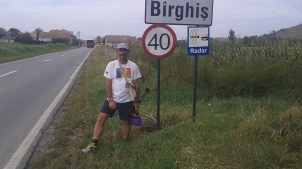
When Alexandru Popescu walked out of his Romanian hometown of Ploieşti, on August 30th, his 84-year old father thought he was crazy. The 46-year-old antiquarian had done some odd things before, like growing organic food on a plot outside the city, or throwing in his lot with activists fighting cyanide-polluting gold mining. But his latest plan was beyond comprehension to his dad. On November 25th, he arrived in Brussels with swollen knees and fewer toenails, wearing a T-shirt bearing the words “No to Cyanide and Fracking.” He had walked 2,900 kilometers to deliver that message to EU policymakers—and by the end of his journey, his father was as proud as a father can be.
Alexandru’s story is part of a much larger one: the spaces of nonviolent resistance to fossil fuel and mineral extraction that are spreading like wildfire around the world. Many of them have been documented by the global atlas of environmental justice created by EJOLT, a research project to catalogue and analyze ecological conflicts.
Movements practicing direct action have already won fracking bans in France and Bulgaria, and most recently in New York State. In many other places they have delayed drilling, and resistance continues to grow across Europe. But with the new European Commission now essentially copying and pasting from the wish list of industry lobby group Business Europe in what may be the largest attack on environmental legislation in EU history, the heat is certainly on.
I spoke with Popescu recently in Brussels.
What made you decide to walk 2,900 kilometers to Brussels?
I worked for three years in the Romanian Ministry of Defense so I’m not easily impressed—but I was impressed with what I saw in the village of Pungesti, where local communities have fiercely resisted Chevron’s plans to explore for shale gas since October 2013. Chevron deceptively tried to create the appearance of public support, but local people who were knowledgeable about fracking started a peaceful resistance camp.
In early December, I learned on Facebook that riot police were attacking the campsite in the middle of the night. Suddenly, it was as if Pungesti was no longer in the EU, with the police acting like Chevron’s private bodyguards. The village was surrounded and even entering it was illegal, but I found a way.
After talking to community members and realizing how bad the situation was, I decided to go on hunger strike. I went to Bucharest’s University Square and stayed there for 22 days, in the open winter air, with temperatures plunging to -20°C (-4F). Several others joined me after two weeks.
What kind of challenges did you have to overcome during your trek?
I lost several toenails, twisted my ankle, and had pain in my knees. But my experience is not important—my message is important. The people resisting fracking in Romania are the ones who are suffering. In Pungesti they received fines for protesting and were detained. Their kids were traumatized and couldn’t go to school, while their parents were unable to feed their livestock. It’s their water that will get poisoned. I walked alone but I carried these people in my heart, so I was never really alone. It helped to know that the UK activist Geza Tarjanyi, better known as Gazyer Frackman, was also walking for the same cause. He submitted a letter to David Cameron from 205 British citizen groups calling for a moratorium on fracking and then joined me in Brussels.
Who listened to you in Brussels?
I participated in a great meeting with Romanians living in the Netherlands, France, Spain, Italy, Germany and other countries—all of them members of either anti-fracking groups or the Save Rosia Montana movement, which is fighting to protect a 2000-year-old village now being threatened by cyanide gold mining. We went with a delegation of 20 people to a meeting with 3 Members of the European Parliament, who congratulated and encouraged us.
The Greens/European Free Alliance group made a short video of the meeting, and said that the journeys taken by Gazyer Frackman and I were just two examples of an ever-growing citizens’ movement against shale gas in Europe. MEP Stefan Eck, of the European United Left/Nordic Green Left group, pledged to call for a European fracking ban at the Parliament’s environment committee.
We were ignored by the Brussels media. However, we do know that our opponents were watching us. They wrote an article on our event.
How is the situation in Romania now?
In Romania, four publications covered my journey and message to Europe, including the country’s biggest newspaper, but it did not create much of a political debate there. Chevron’s exploratory drilling is now finished (and Pungesti awaits the results), but the exploitation is not. Almost 70% of our country’s land has been leased to oil and gas companies.
But I didn’t walk to Brussels to solve a Romanian issue. We need a Europe-wide ban on fracking and cyanide mining, and we’re building a movement to get it.
You can learn more about resistance to fracking in Romania here.
Email ejoltmap@gmail.com if you know of a space of resistance to fracking that is missing from our environmental justice atlas. The atlas is a work in progress and entirely depends on input from grassroots activists. The reviewers will brief you on how to do it.
Nick Meynen writes blogs and books on topics like environmental justice, globalization and human-nature relationships. When he’s not wandering in the activist universe and his Facebook page is dead, he’s probably walking in nature.

The project ENVJUSTICE has received funding from the European Research Council (ERC) under the European Union’s Horizon 2020 research and innovation programme (grant agreement No. 695446)